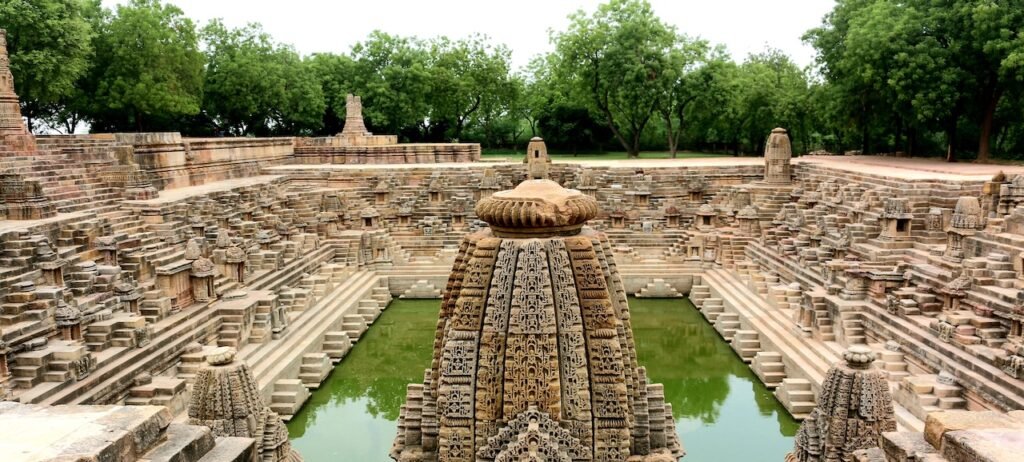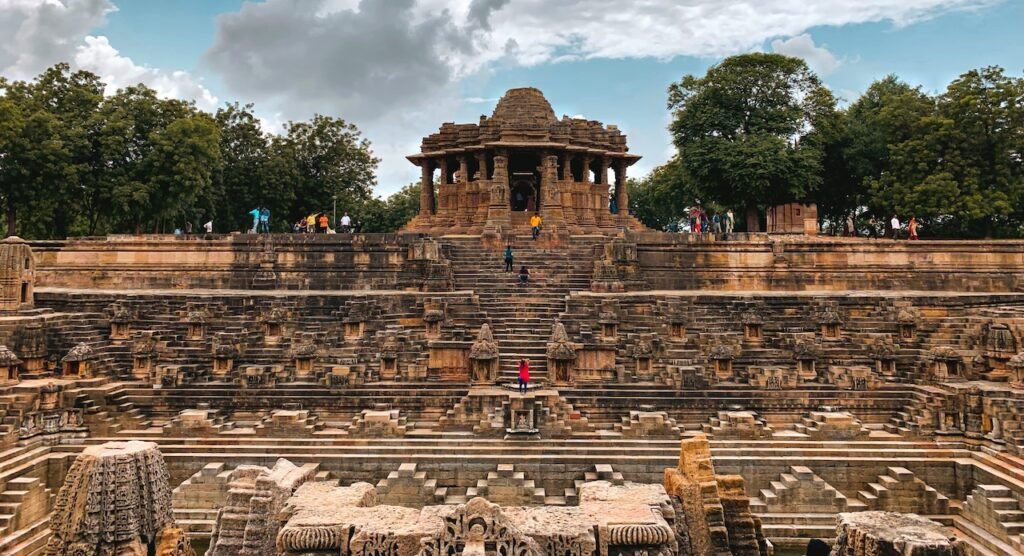The Modhera Sun Temple stands as one of India’s architectural marvels, seamlessly blending history, cultural legacy, and spiritual allure in the heart of Gujarat. This article explores every facet of the legendary temple, from its ancient origins, architectural brilliance, and rich legends to its current status as a globally recognised heritage monument and renewable energy hotspot.
Introduction
Modhera Sun Temple, situated on the banks of the Pushpavati River in Gujarat, is a heritage monument renowned for its spiritual resonance and exquisite artistry. Built in the 11th century by Bhima I of the Chaulukya dynasty, this temple not only tells stories of devotion but also of the scientific genius of its creators, who meticulously aligned its sanctum with the sun’s movement during equinoxes.
History of Modhera Sun Temple
Constructed around 1026-27 CE, the Modhera Sun Temple emerged during the reign of Bhima I, a period marked by prosperity and cultural dynamism in Gujarat. Many records suggest it commemorates the resilience of the local population against the invasions of Mahmud Ghazni, with inscriptions indicating both its destruction and subsequent reconstruction during that era. Legends from the Skanda and Brahma Purana further entwine its history with the epic tale of Lord Rama, enhancing its mythical dimension.
Architectural Splendor
The temple is a masterpiece of the Maru-Gurjara architectural style, illustrating intricate craftsmanship and astronomical acumen. It comprises three principal sections:
- Gūḍhamanḍapa (Shrine Hall): Traditionally housed the sacred idol of Surya, adorned with elaborate sculptures and motifs, though no deity resides there now.
- Sabhamanḍapa (Assembly Hall): Radiates with twelve representations of ‘Adityas’, symbolising the twelve solar months, each pillar a testament to artisans’ skill.
- Kunda (Stepwell): Named Suryakund or Ramkund, this large tank features over 100 tiny shrines lined around its steps, showcasing harmonious Vedic and solar symbolism.
During the equinoxes, the sun’s first rays directly illuminate the sanctum sanctorum, a celestial phenomenon drawing widespread admiration.
Cultural and Spiritual Significance
The temple’s sculptures and legends represent a confluence of Hindu mythology and ancient Indian science. As a major site for Vedic rituals and solar worship, its design reflects the reverence for natural elements, vital in early Indian spiritual practices. Although regular worship has ceased, its aura continues to inspire pilgrims and scholars from around the world.
Modhera Sun Temple as a Tourist Destination
The Modhera Sun Temple, now a protected monument under the Archaeological Survey of India, attracts tourists and researchers from around the world. Along with its ancient charm, recent additions such as the 3-D Projection Mapping Show and Heritage Lighting have enriched the visitor experience, offering immersive historical storytelling.
Location and Access
- Location: Village Modhera, Mehsana district, Gujarat. Coordinates: 23.583806°N 72.1326861°E.
- Road: 26 km from Mehsana, 99 km from Ahmedabad.
- Rail: Nearest station in Mehsana, 28 km away.
- Air: The Closest airport is in Ahmedabad, about 95 km by road.
Tourism Statistics and Revenue
The temple experiences a steady influx of visitors, often numbering in the hundreds of thousands each year. In 2018, over 293,000 resident visits were recorded. The site has benefited from broader heritage tourism campaigns, which have boosted revenues and regional economic growth through ticket sales, hospitality, and cultural programs.

Solar-Powered Legacy: India’s First Solar Village
In October 2022, Modhera became India’s first 24/7 solar-powered village, a project launched by the Prime Minister that integrates modern renewable energy into its heritage. Rooftop and ground-mounted solar plants now supply electricity around the clock, echoing the temple’s age-old solar associations. Local residents reportedly save 60%-100% on their electricity bills, making Modhera a model for sustainable rural development.
Modhera Sun Temple in Recent News
The temple regularly makes news headlines for hosting international events, including G20 conferences and cultural festivals. These gatherings highlight its enduring appeal, positioning Modhera as both a heritage site and a symbol of modern India’s clean-energy ambitions.
FAQs About Modhera Sun Temple
What is the historical significance of Modhera Sun Temple?
The temple commemorates medieval Gujarat’s prosperity and resilience against invaders, and is rooted in rich local and epic legends.
Is the Modhera Sun Temple still active for religious worship?
The temple is no longer used for religious ceremonies, but it remains a revered monument and a popular tourist attraction.
How can visitors reach Modhera Sun Temple?
It is accessible by road via Mehsana, by train from Mehsana Junction, and via flights landing at Ahmedabad airport.
What makes the temple’s architecture unique?
The temple’s design is aligned with the sun’s movement, and features intricately carved halls, pillars, and a sacred stepwell with 108 shrines.
What are the major tourist experiences and facilities?
Visitors enjoy the temple’s historical structures, solar-powered lighting shows, guided walks, and regional hospitality services.
How has solar power transformed Modhera?
Modhera’s solar initiative provides the entire village with renewable electricity, making it an exemplary “solar village” with global recognition.
Are there any special events or festivals held at the temple?
Yes, festivals and international conferences, such as those hosted by the G20 and cultural organisations, celebrate their past and present influence.
